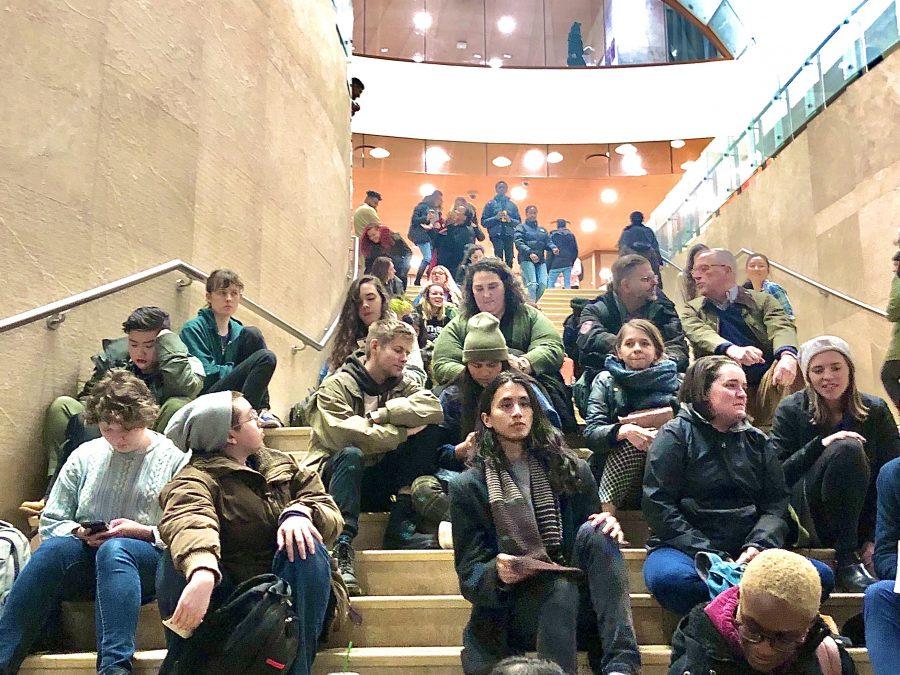Scattered on the steps of the Kimmel Center of University Life on Wednesday evening, more than 50 NYU community members gathered to commemorate lives lost to transphobic violence in observance of the annual Transgender Day of Remembrance.
The Transgender Day of Remembrance was first organized in 1999 by activist Gwendolyn Ann Smith to memorialize Rita Hester, a transgender woman killed in Massachusetts in 1998. Hosted by the NYU LGBTQ+ Center, the vigil finalized Trans Awareness Week at NYU. It featured speeches from a transgender student and NYU staff member, as well as a reading of the names of those killed by anti-transgender violence in the last year.
“So much of trans life is defined by pain, the pain of gender dysphoria, of hormone injections and surgery, rejection from family and friends,” said Alexander Pines, a staff member at the Office of Student Success, to the crowd. “Trans Day of Remembrance and Resilience began as a day to recognize absence, to hold space for those who are not here and to specifically name our loss as members of the trans, gender non-conforming and non-binary communities.”
Nearly 3,314 people died at the hands of anti-transgender violence globally between 2008 and September of this year, as recorded by Trans Respect vs Trans Phobia Worldwide. Pines said that, even this is most likely not a full figure due to transgender deaths being incorrectly and underreported.
“In more instances than I can count, these deaths are reported on inaccurately, with the wrong names and pronouns,” Pines said.
The vast majority of the death toll is comprised of transgender women of color, who are one of the most vulnerable and persecuted groups in the U.S.
“When you’re marginalized and you have multiple reasons for your marginalization, like race and sexuality or gender, then it’s very easy for you to be forgotten by society,” CAS first-year Iman Yusuf, who attended the vigil, told WSN. “The huge problem that we’re having in America with black trans women being killed, nobody pays attention to it.”
Tisch first-year Charlie Anderson echoed the sentiment that trans people of color needed to be protected, adding that it should be a joint effort.
“Considering that the majority of the people killed this year are specifically black trans women, this is the moment where I think we all come together as a community to honor and commit to changing our world,” Anderson told WSN.
Gallatin first-year Trix Willems emphasized the importance of community to the Trans Day of Remembrance and said he felt it was crucial for the event to be held on the Kimmel steps.
“I think it’s important that there’s a good showing of people as well and I’m glad that it’s in this space,” Willems told WSN. “People are asking, ‘Oh what is this, what are you guys doing?’ and to be able to say that we’re here to remember and honor trans people is really important.”
Tandon senior and President of oStem — an organization at NYU that aims to empower members of the LGBTQ community in STEM fields — Tarek Hassoun also gave a speech. She hopes the event’s visibility would encourage others to act.
“We no longer have the time or energy to deal with empty allyship,” Hassoun said in her speech. “I ask that you use your privilege to stand up for us and to allow us to stand up for ourselves.”
Along similar lines, Pines called upon vigil attendees to consider how they could make everyday systems more welcoming to transgender individuals.
While the event was meant to commemorate lives lost, Pines stressed the need to not frame transgender identity as one of victimhood.
“Most stories about trans life revolve around being trapped in bodies that are somehow wrong before getting medical procedures that allow me to be happy and whole, stories that often collapse the beauty and terror, the joy and grief of being trans into something palatable,” Pines said. “I’m not happy necessarily, or fixed or whole, but I am more than pain.”
Email Lisa Cochran at [email protected].

























































































































































